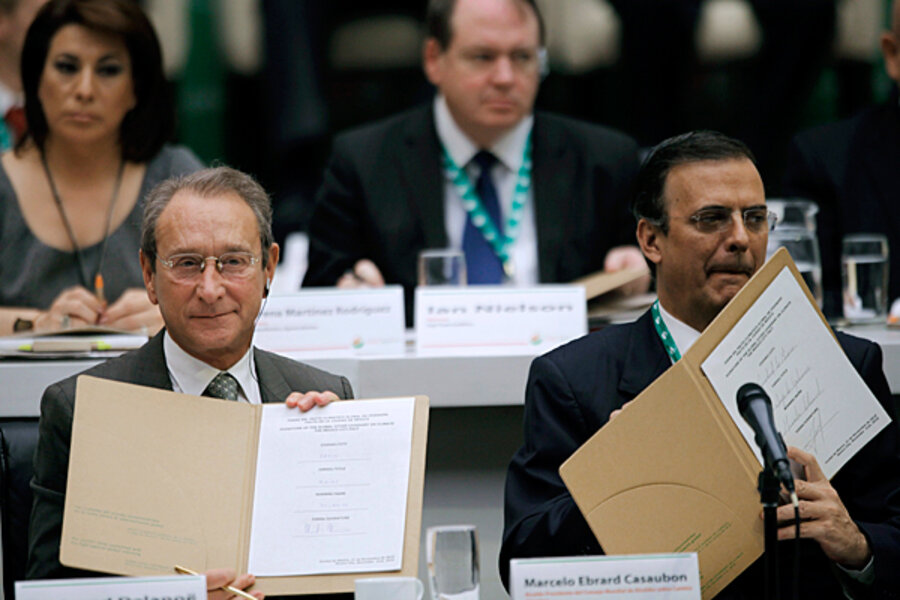Global warming: carbon dioxide emissions worldwide fell in 2009
Loading...
Industrial carbon-dioxide emissions, the driver behind a new round of global climate talks set to begin in Cancun, Mexico, Nov. 29, eased in 2009, according to a group of scientists monitoring atmospheric CO2.
Emissions from burning coal, oil, and natural gas fell 1.3 percent compared with emissions in 2008, notes in the team from the Global Carbon Project, set up in 2001 to keep track of CO2 emissions as well as conduct research on Earth's carbon cycle.
Even so, concentrations of CO2 rose last year to a level where, for every 1 million molecules of gases in the atmosphere, 387 of them were carbon dioxide. By contrast, the average level for 2008 was 385 ppm.
Concentrations continued to rise even as emissions slipped because even at the reduced pace, humans are pumping CO2 into the atmosphere faster than natural processes can scrub the gas, meaning that human emissions can stay in the atmosphere for centuries, if not longer.
“More CO2 is staying in the atmosphere instead of being absorbed by the ocean and land sinks, like trees and other vegetation,” said Richard Feely, an oceanographer at the National Oceanic and Atmospheric Administration's Marine Environmental Laboratory in Seattle and a member of the team producing the report.
“We’re concerned that if the natural sinks can't keep pace with the increased CO2 emissions, then the physical and biological impacts of global warming will accelerate over the next century.”
The rising concentration highlights the challenge negotiators headed to Cancun face in confronting global warming.
Many countries have agreed in principle to try to stabilize emissions at 350 parts-per-million by century's end. That would result in a 50 percent chance of holding the increase in global average temperatures to about 2 degrees C over preindustrial levels. Yet stabilizing concentrations at any level essentially means ceasing emissions once the desired level is achieved. Global CO2 concentrations already have passed the 350 mark.
La Niña
Among the factors the team cites for lower emissions last year: the global economic downturn and an increase in carbon-dioxide uptake by the oceans and by plants on land, encouraged by La Niña. La Niña is one-half of a natural seesaw shift in climate that takes place across the tropical Pacific every three to seven years.
This swing "has a very clear impact on global carbon cycle," says Pierre Friedlingstein, an atmospheric scientist at the University of Exeter in Britain and the lead author of a summary of the reports findings that appears in the current issue of the journal Nature Geoscience.
During a La Niña event, the climate is cooler and wetter over large regions of land in the tropics, encouraging plant growth in tropical forests, he explains. During El Niño, the other half of the cycle, these same land areas warm up and dry out, slowing plant growth.
Current estimates suggest that if CO2 concentration doubled, the global average temperature would rise by about 3 degrees Celsius. So far, the global average temperature has risen about 0.7 degrees C since the mid 1800s. The vast majority of atmospheric scientists attribute the increase – particularly during the past 30 to 50 years – in large part to the build-up of heat-trapping CO2 in the atmosphere from human industrial activity.
The decline in emissions last year was the largest among countries in Europe, as well as in the US and Japan, the report notes. But in other parts of Asia, continued economic growth continued to drive emissions up by 8 percent in China, 6.2 percent in India, and 1.4 percent in South Korea.
The Global Carbon Project team posits that with these numbers in Asia as a foundation, overall emissions are poised to return to prerecession levels as economies around the world begin to recover.
Between 2000 and 2008 emissions outpaced all but the highest emissions scenarios set out in the last set of climate reports from the Intergovernmental Panel on Climate Change in 2007. Emissions grew by 3 percent a year during that time.
If projections for growth in 2010 from the International Monetary Fund hold, the team calculates, emissions could return to a similar level as early as this year.
Progress on deforestation
For negotiators in Cancun, the report carries some encouraging news. One of the key issues involves including in any new climate agreement ways to encourage developing countries with topical forests to prevent further deforestation.
Emissions from deforestation and other land-use changes account for about 20 percent of CO2 emissions from human activities.
The Global Carbon Project team notes that emissions in 2009 would have been higher but for efforts to control deforestation in countries such as Indonesia and Brazil during the past decade. In addition, the team reports, the modest expansion of forests in Eurasia since the 1950s contributed as well. Since 2000, these forests have acted as what the team refers to as a small net sink in CO2.





